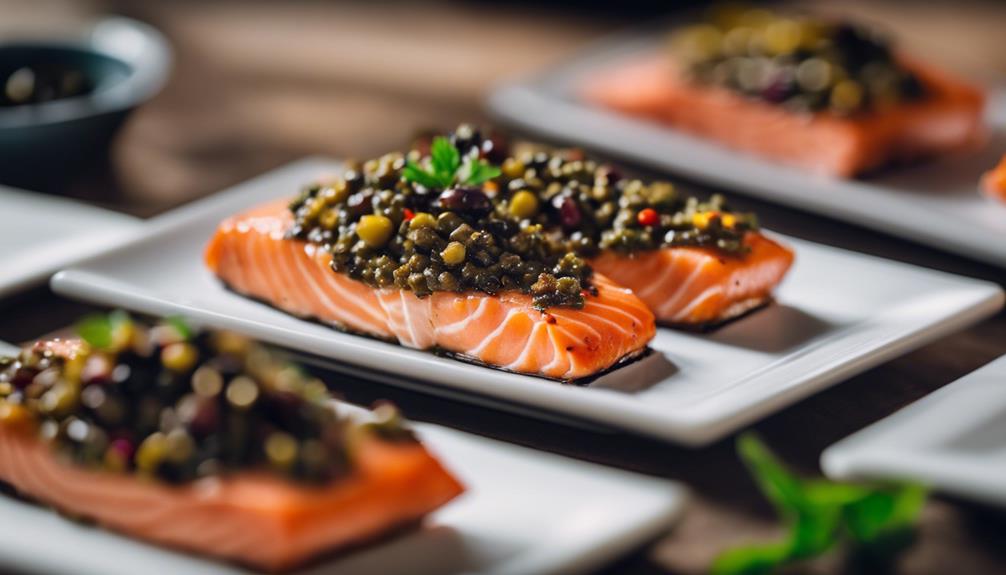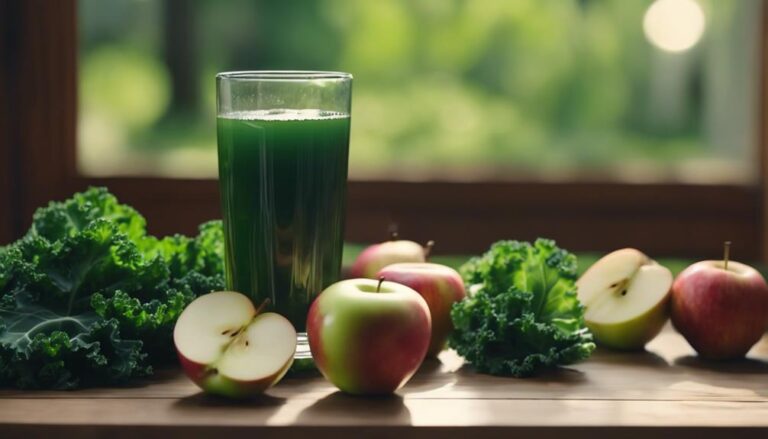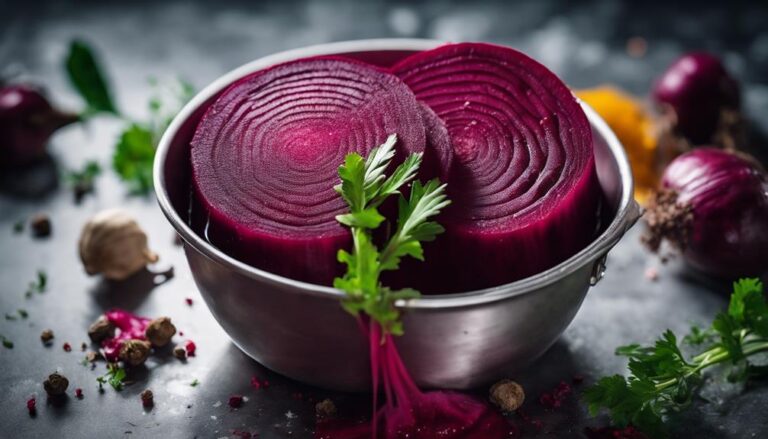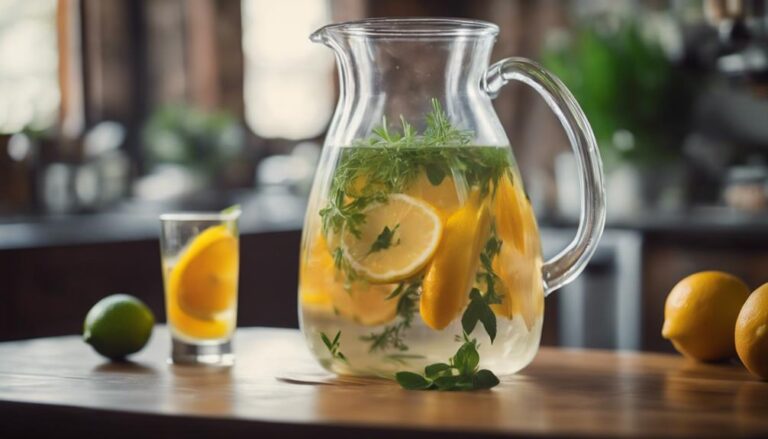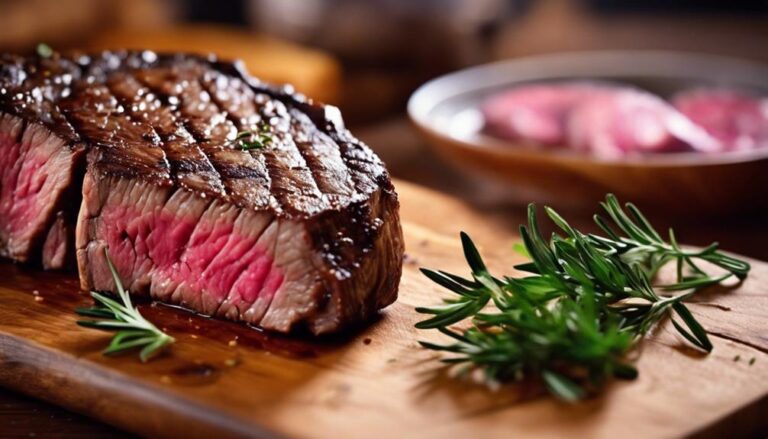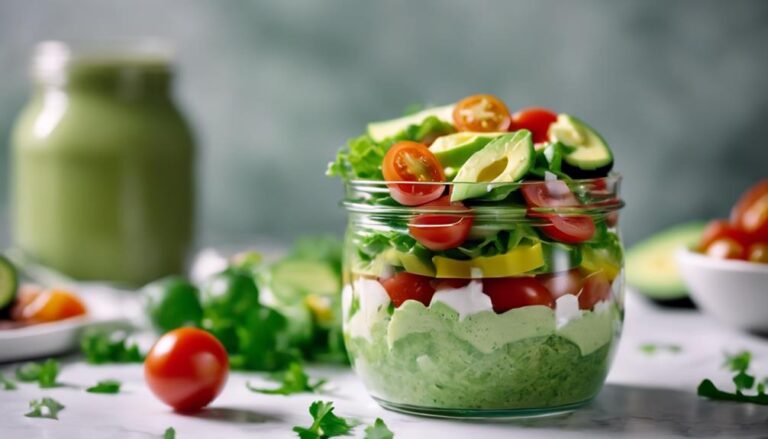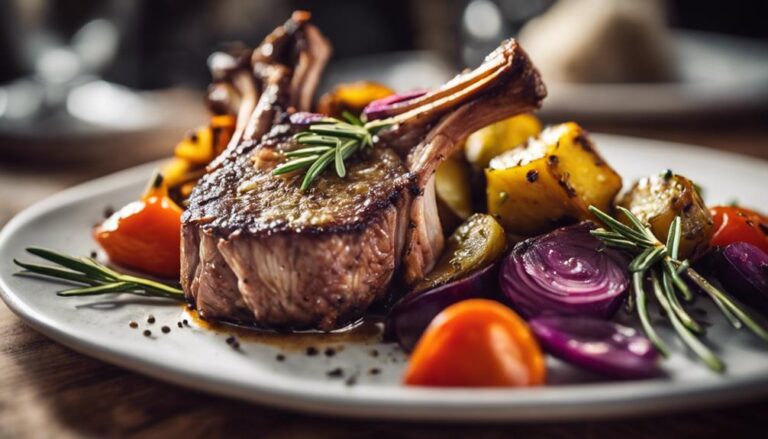Sous Vide Salmon With Olive Tapenade
Enhance your sous vide salmon with flavorful olive tapenade. Seal salmon with olive oil, salt, and pepper in a bag. Cook in a water bath for perfect tenderness. Create tapenade by blending olives, capers, anchovies, and herbs. Spread tapenade over salmon before searing for a crispy finish. Enjoy the rich, savory taste of salmon paired with the tangy olive mixture. For more seasoning options and cooking techniques to elevate your salmon dish, discover the culinary possibilities waiting for you.
What You Will Learn Here
- Prepare salmon sous vide at precise temperature and time for optimal texture and flavor.
- Create a flavorful olive tapenade with olives, capers, garlic, herbs, and olive oil.
- Finish sous vide salmon by searing for a crispy exterior and added depth of flavor.
- Serve sous vide salmon with olive tapenade as a savory topping for a gourmet touch.
- Elevate the dish with a garnish of fresh herbs or a drizzle of balsamic reduction for enhanced taste.
Salmon's Ancient Culinary Roots
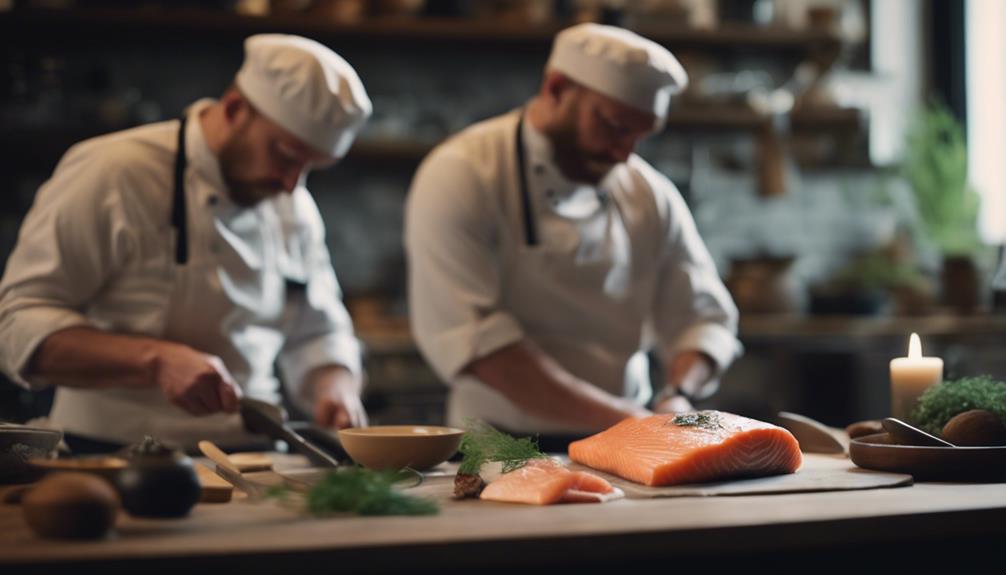
Salmon has a rich history in ancient culinary traditions, with evidence of its consumption dating back centuries. Historical salmon recipes offer a glimpse into how this prized fish was prepared and enjoyed in different cultures.
The culinary evolution of salmon showcases how this versatile ingredient has adapted over time to suit changing tastes and cooking techniques.
Salmon in Ancient Cuisine
In ancient cuisine, salmon played a significant role as a staple protein source for many cultures. Ancient salmon harvesting was a crucial practice for communities living near rivers and oceans. The cultural significance of salmon went beyond sustenance, with many societies attributing symbolic meanings to this prized fish. Salmon preservation techniques, such as smoking and drying, were developed to guarantee a stable food supply throughout the year.
Salmon held a special place in the culinary traditions of various ancient civilizations, symbolizing abundance, fertility, and renewal. The rich flavor and nutritious benefits of salmon made it a sought-after ingredient for feasts and everyday meals alike. Whether caught in rivers or oceans, salmon was valued for its versatility in cooking and its ability to be preserved using different methods. The respect for salmon in ancient cuisine highlights the deep connection between food, culture, and the natural world.
Historical Salmon Recipes
Delving into the annals of culinary history reveals a tapestry of ancient recipes that showcase the diverse ways in which salmon was prepared and enjoyed. Salmon holds a special place in the historical culinary landscape due to its cultural significance and the various methods developed for its preservation. In ancient times, salmon was a prized food source for many indigenous cultures, including the Native American tribes of the Pacific Northwest and the Scandinavian peoples.
Salmon preservation methods played a significant role in ensuring a year-round supply of this nutritious fish. Techniques such as smoking, drying, and salting were commonly used to preserve salmon for extended periods. These methods not only helped in food preservation but also added unique flavors to the fish, enhancing its taste and texture.
Culturally, salmon was often associated with abundance, fertility, and prosperity. In many societies, salmon was a symbol of renewal and was incorporated into rituals and celebrations. Its presence in ancient recipes and ceremonies highlights the profound connection between salmon and the communities that relied on it for sustenance and cultural significance.
Culinary Evolution of Salmon
Exploring the culinary evolution of this esteemed fish reveals a rich tapestry of ancient techniques and traditions that have shaped its place in gastronomy. Salmon has been a staple in diets for centuries, with historical recipes showcasing various methods of preparation. From smoking to curing, early civilizations valued salmon not just for its taste but also for its nutritional benefits. The fish is rich in omega-3 fatty acids, protein, and essential vitamins, making it a vital ingredient in ancient cuisines.
As culinary practices evolved, so did the techniques for preparing salmon. Modern methods such as sous vide cooking have revolutionized the way this fish is enjoyed, enhancing its natural flavors and maintaining its nutritional value. Additionally, sustainability efforts have become essential in preserving salmon populations and ecosystems, ensuring that future generations can continue to savor its delicate taste.
The flavor profiles of salmon have also diversified over time, with chefs experimenting with different seasonings and accompaniments to create unique dishes. By embracing both tradition and innovation, the culinary journey of salmon continues to captivate taste buds around the world.
Salmon's Versatile Seasoning Options
Consider experimenting with a variety of herbs and spices to enhance the flavor profile of your salmon dish. Seasoning your salmon can elevate its taste and add depth to the overall dining experience. Here are some versatile seasoning options to try:
- Classic Lemon and Dill: A timeless combination that complements the natural flavors of salmon beautifully.
- Spicy Cajun Blend: Add a kick to your salmon with a Cajun spice mix for a bold and flavorful twist.
- Asian-inspired Sesame Ginger: Infuse your salmon with a mix of sesame oil, ginger, and soy sauce for a fusion of delicious flavors.
- Herbaceous Pesto: Spread a layer of pesto on your salmon before cooking to infuse it with aromatic herbs like basil, pine nuts, and Parmesan cheese.
Exploring different spices can transform your salmon dish into a culinary delight. By incorporating modern cooking techniques and a creative mix of seasonings, you can create a meal that's both nutritious and bursting with flavor.
Tasty Salmon Variations
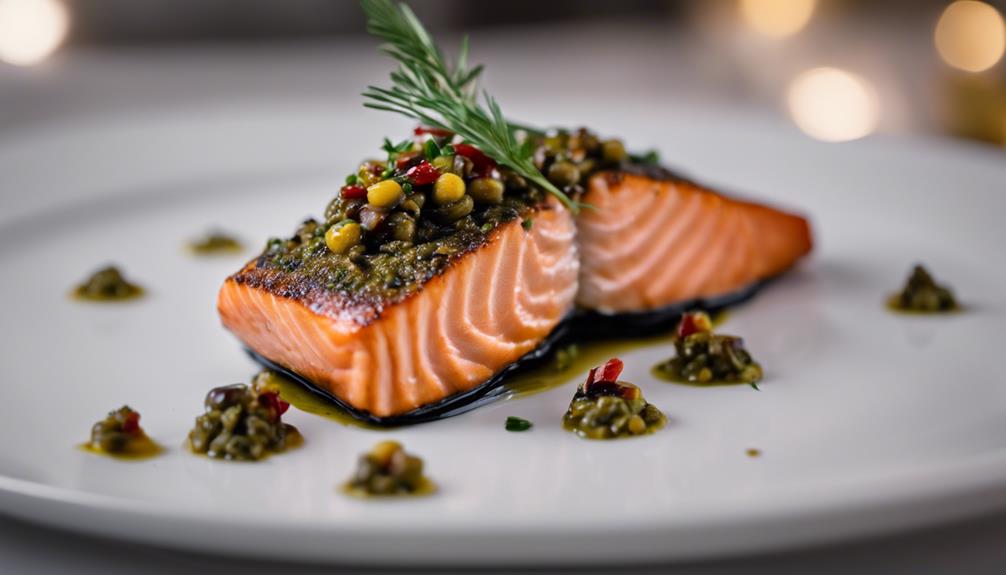
When it comes to preparing salmon, there are a few tasty variations you should consider.
Try making Sous Vide Salmon with dill for a revitalizing herbal twist or opt for Sous Vide Salmon with lemon for a zesty, citrusy flavor.
These variations can elevate the taste of your salmon dish and add a new dimension to your culinary repertoire.
Sous Vide Salmon Preparation
To enhance the flavor profile of your sous vide salmon, experiment with various tasty variations such as a zesty citrus marinade or a savory herb-infused butter. When preparing your salmon, keep in mind the importance of sous vide temperature control and the wide array of marinade options available.
Here are some delicious ways to elevate your sous vide salmon:
- Citrus Infusion: Marinate your salmon in a mixture of lemon or orange juice, zest, and a touch of honey for a lively and invigorating flavor.
- Asian-Inspired Marinade: Combine soy sauce, ginger, garlic, and a hint of sesame oil for a delicious umami kick.
- Herb Butter: Create a compound butter with fresh herbs like dill, parsley, and chives to add a burst of herby goodness to your salmon.
- Spicy Rub: Mix together paprika, cayenne pepper, garlic powder, and brown sugar to create a spicy rub that will give your salmon a flavorful kick.
These variations will take your sous vide salmon to the next level, offering a burst of exciting flavors with each bite.
Sous Vide Salmon With Dill
Enhance your sous vide salmon with the vibrant and fresh flavor of dill, elevating each bite with a burst of herbaceous goodness. Dill pairing with sous vide salmon creates a delightful fusion of flavors that will leave your taste buds craving more. Here's why this combination is a must-try:
- Herbaceous Harmony: The gentle, aromatic quality of dill perfectly complements the rich taste of sous vide salmon, creating a harmonious blend of flavors that dance on your palate.
- Flavor Infusion: When you sous vide salmon with dill, the herb infuses the fish with its essence, ensuring that every mouthful is packed with a rejuvenating and savory taste.
- Freshness Factor: Dill's bright and fresh notes add a layer of complexity to the salmon, lifting the dish to new heights of culinary delight.
- Versatile Elegance: Whether you're serving a casual weeknight dinner or hosting a special gathering, sous vide salmon with dill brings an air of elegance to any occasion.
Sous Vide Salmon With Lemon
Elevate your sous vide salmon experience by infusing it with the invigorating brightness of lemon, creating a tantalizing variation that will enliven your taste buds. Lemon zest adds a revitalizing kick to the salmon, enhancing its natural flavors and providing a burst of citrusy goodness.
To achieve the perfect Sous Vide Salmon With Lemon, follow these steps:
- Prepare the Citrus Marinade: Whisk together lemon juice, olive oil, minced garlic, salt, and pepper to create a flavorful marinade for the salmon.
- Coat the Salmon: Rub the lemon zest onto the salmon fillets, ensuring an even distribution of the vibrant zest.
- Marinate the Salmon: Place the salmon fillets in a resealable bag or vacuum-sealed pouch, pour the citrus marinade over them, and let them marinate in the refrigerator for at least 30 minutes.
- Sous Vide Cooking: Cook the salmon in a water bath at the desired temperature for a moist and tender texture that perfectly complements the bright lemon flavors.
Enjoy your Sous Vide Salmon With Lemon for a delicious and citrusy culinary experience.
Sous Vide Timing Tips
When it comes to sous vide cooking, timing is key for achieving perfect doneness.
You must maintain precision in cooking to make sure that your salmon turns out just right.
Timing for Perfect Doneness
For perfectly cooked salmon using sous vide, timing is essential to achieve the desired level of doneness. Temperature control and cooking techniques play a vital role in guaranteeing your salmon turns out just right. The beauty of sous vide cooking lies in its precision, allowing you to set the exact temperature for your fish and maintain it throughout the cooking process.
When it comes to timing, it's important to take into account the thickness of your salmon fillet. Thicker cuts will require longer cooking times to make sure they're cooked evenly. As a general guideline, for a one-inch thick salmon fillet, you can cook it at 125°F for about 45 minutes for a tender and moist result. However, if you prefer your salmon more well-done, you can increase the temperature slightly and adjust the cooking time accordingly.
Precision in Cooking
To guarantee precise cooking results when using sous vide, focus on mastering the timing tips for achieving the perfect doneness in your salmon fillet. Temperature control is key in sous vide cooking. Confirm your water bath is set to the exact temperature recommended for salmon, typically around 110-125°F.
Cooking precision is essential; even a few degrees can impact the final texture of your fish. When timing your salmon, remember that thicker fillets will require longer cooking times compared to thinner cuts. A general rule is to cook salmon for 30-45 minutes for fillets that are about 1 inch thick. However, for thicker cuts, you may need to extend the cooking time. Use a timer to keep track accurately.
Ensuring Even Cooking
Achieve consistent and uniform cooking results in your sous vide salmon by paying close attention to the timing tips for best doneness. Temperature control is vital in sous vide cooking to guarantee your salmon is cooked to perfection. Set your sous vide water bath to the precise temperature recommended for salmon, typically around 110-130°F (43-54°C), depending on your desired doneness. This controlled environment allows the fish to cook gently and evenly without overcooking.
When following the sous vide cooking technique for salmon, timing is key. Depending on the thickness of your salmon fillet, cooking times may vary. As a general guide, cook thin fillets for around 30-45 minutes, while thicker cuts may require up to 1-2 hours. Ensuring that the salmon is in the water bath for the appropriate duration will result in a moist, tender, and perfectly cooked piece of fish.
Final Thoughts
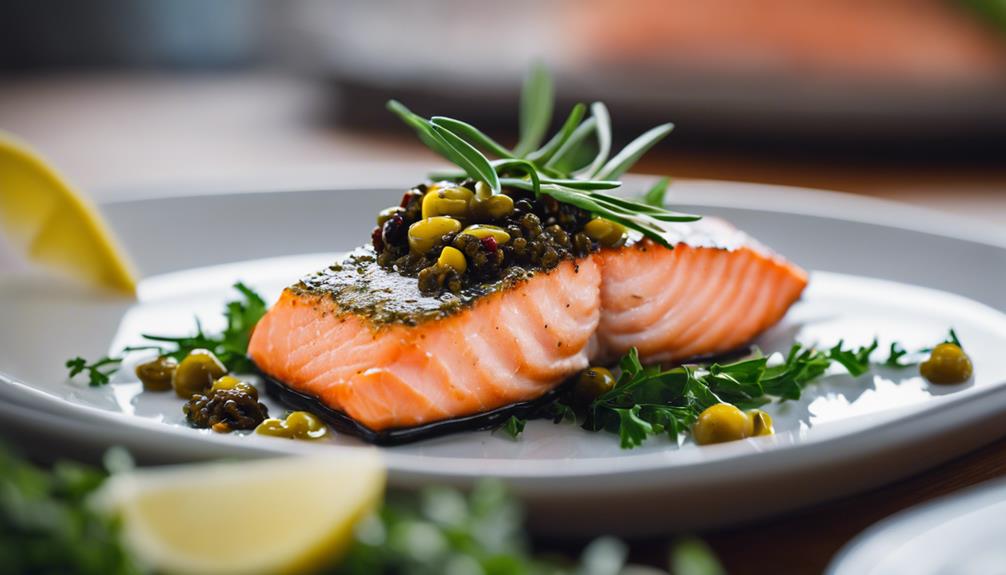
To conclude, contemplate the flavors and textures that harmonize in this delightful dish. The reflections on the sous vide salmon with olive tapenade reveal a beautiful interplay of taste profiles. The salmon, cooked to tender perfection, offers a buttery and delicate flavor that pairs exquisitely with the briny and piquant notes of the olive tapenade. The subtle saltiness of the salmon enhances the savory richness of the tapenade, creating a symphony of flavors that dance on your palate.
The flavor profiles in this dish aren't only delicious but also sophisticated. The sous vide method guarantees that the salmon retains its moisture and tenderness, allowing the natural flavors to shine through. The olive tapenade, with its blend of olives, capers, and herbs, adds a burst of Mediterranean flair that elevates the dish to a gourmet level.
Frequently Asked Questions
Can I Use Frozen Salmon for Sous Vide Cooking?
Yes, you can use frozen salmon for sous vide cooking. To guarantee even cooking, it's advisable to defrost the salmon before placing it in the sous vide. Adjust cooking times slightly to accommodate for starting with frozen fish.
How Long Can I Store Homemade Olive Tapenade?
To keep your homemade olive tapenade fresh, store it in an airtight container in the fridge. It should stay good for about 1-2 weeks. Remember to check for any signs of spoilage and use your senses to gauge its freshness.
Can I Substitute Salmon With Other Types of Fish?
When swapping fish types, consider flavor profiles for the best fit. Explore sous vide techniques for various fish options. Experiment with substitutions like cod or halibut for diverse flavors and textures in your dishes.
Is It Possible to Overcook Salmon Using Sous Vide?
Yes, it's possible to overcook salmon with sous vide if you exceed the proper timing. Temperature precision is essential for texture control and moisture retention. Keep an eye on the clock to achieve that perfect, tender result.
Can I Add Additional Herbs to the Olive Tapenade for Flavor?
Yes, you can definitely add additional herbs to the olive tapenade for more flavor. Experiment with different herb combinations like rosemary, thyme, or basil to elevate the taste of your tapenade and create a unique culinary experience.
Conclusion
To sum up, sous vide salmon with olive tapenade offers a delightful combination of flavors and textures that's sure to impress your taste buds.
By understanding the ancient culinary roots of salmon, experimenting with versatile seasoning options, and exploring tasty variations, you can create a dish that's both delicious and nutritious.
Remember to follow sous vide timing tips for perfectly cooked salmon every time.
Enjoy the culinary journey of preparing this exquisite dish in your own kitchen.
